When it comes to tariff policies on US imports, a clear disparity emerges among major global trading nations. According to a Moneycontrol analysis of World Bank data, India and Vietnam impose relatively higher tariffs on US products compared to China, Indonesia, and Mexico. This nuanced trade dynamic may put India and Vietnam under greater scrutiny from policymakers in Washington, especially as tariffs remain a contentious issue in US trade relations.
The Numbers Behind the Tariffs
India imposes tariffs of 10 percent or less on 65.3 percent of US imports, a figure that pales in comparison to China’s 90 percent. Similarly, Mexico and Indonesia offer more favorable terms to US exports, with 80 percent and 79 percent, respectively, of US goods attracting tariffs of 10 percent or less. Vietnam, often compared to India in this regard, imposes 10 percent or less on 63.5 percent of US imports, slightly trailing behind India but still far below China’s liberal tariff structure.

The Steep Slope of Indian Tariffs
India’s tariffs escalate faster than many of its counterparts. For instance, 17.9 percent of US imports to India face duties in the 10-20 percent range, and 15.1 percent attract 20-30 percent tariffs. By comparison, in Vietnam, 24.4 percent of US imports fall within the 10-20 percent duty range, while 9.2 percent face duties between 20-30 percent. Moreover, 4 percent of goods entering India are subject to tariffs exceeding 30 percent, a rate slightly higher than Vietnam’s 3 percent.

This sharper escalation in tariffs may contribute to India’s perception as a more protectionist market. Such steep tariffs could invite stricter trade measures from the US, particularly under an administration keen on addressing what it views as unfair trade practices.
China, Indonesia, and Mexico: A Friendlier Tariff Regime
China, Indonesia, and Mexico stand out for their relatively open markets for US goods. Only 1 percent of US imports to these countries are subject to tariffs exceeding 30 percent, demonstrating a significantly more welcoming environment for American exports. These nations offer over 75 percent of their US imports tariffed at 10 percent or less, cementing their positions as more favorable trade partners in terms of tariff policies.
The Bigger Picture: Limited Gains from Tariff Reductions
Despite the headline-grabbing rhetoric on tariffs, the practical gains from tariff reductions for the US are limited. A previous Moneycontrol analysis found that even if the US were to dominate the market for products facing over 40 percent tariffs, the resulting export gains would amount to just $5 billion. While this is a notable figure, it’s not transformative in the grand scheme of US trade deficits or overall export volume.
The Trump Factor and Future Implications
Trade tensions between the US and its partners are not new, but the focus often shifts based on the political landscape. Former President Donald Trump, during his tenure, imposed 40 percent tariffs on some Chinese goods and suggested a 60 percent tariff on others. He also voiced opposition to the idea of a BRICS currency, threatening additional tariffs on BRICS nations, including India.
Under such scrutiny, India’s relatively high tariff rates, especially on goods attracting more than 30 percent, could make it a target for future trade measures, particularly as Vietnam—a key competitor for manufacturing investment—offers similar yet marginally more favorable terms.
What’s Next for India and Vietnam?
India’s and Vietnam’s tariff structures reflect broader economic policies aimed at protecting domestic industries. However, as global supply chains shift and nations vie for a share of manufacturing and export opportunities, particularly with the US, the pressure to adopt more liberal trade policies may increase. For India, balancing the need to protect local businesses with the imperative of being an attractive trade partner will remain a delicate task.
As trade relations evolve, countries like China, Indonesia, and Mexico, with their lower tariffs on US goods, may gain a competitive edge. Whether India and Vietnam adjust their strategies to align with global trends or continue on their current path could define their trade dynamics with the US in the years to come.


